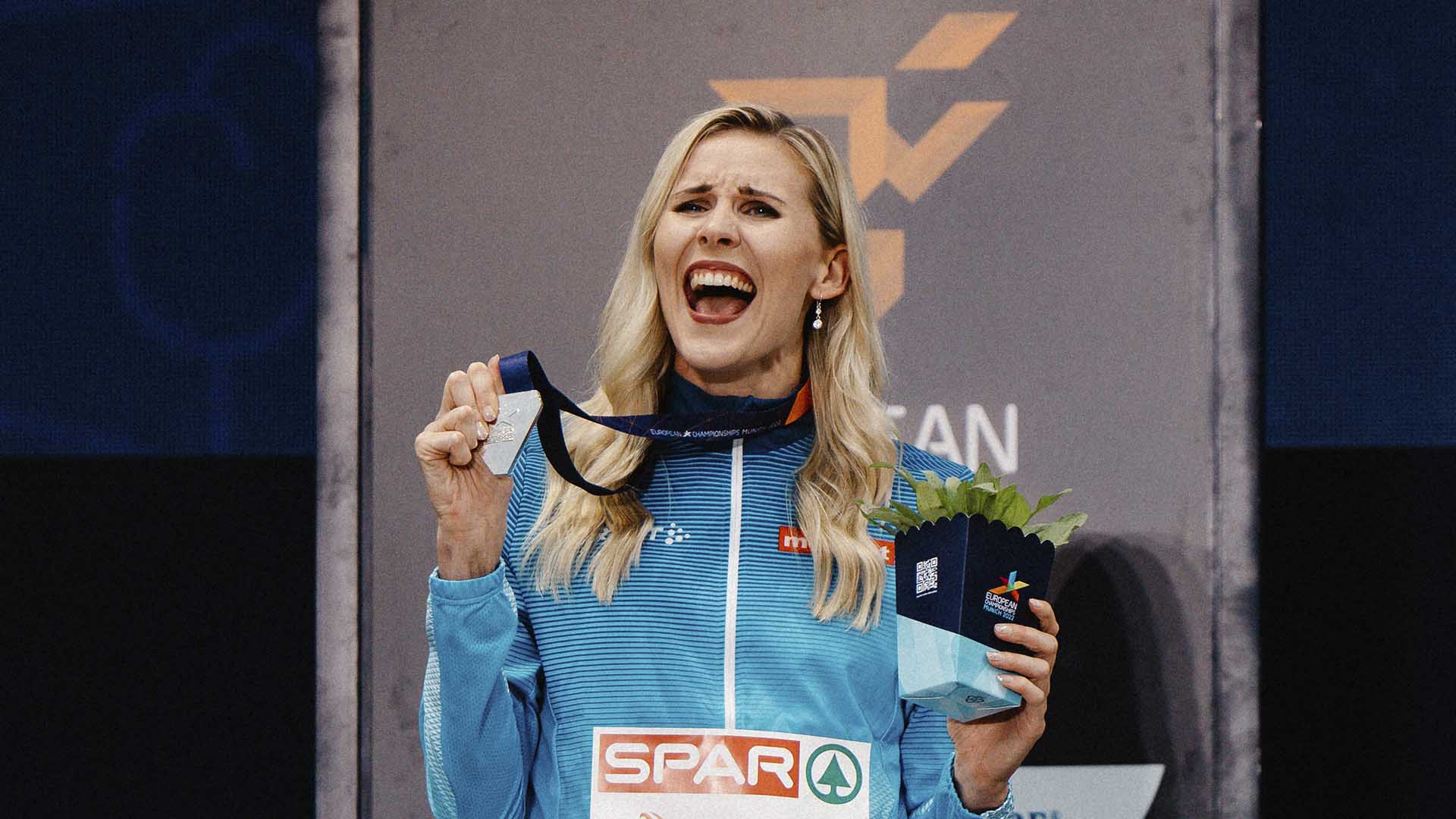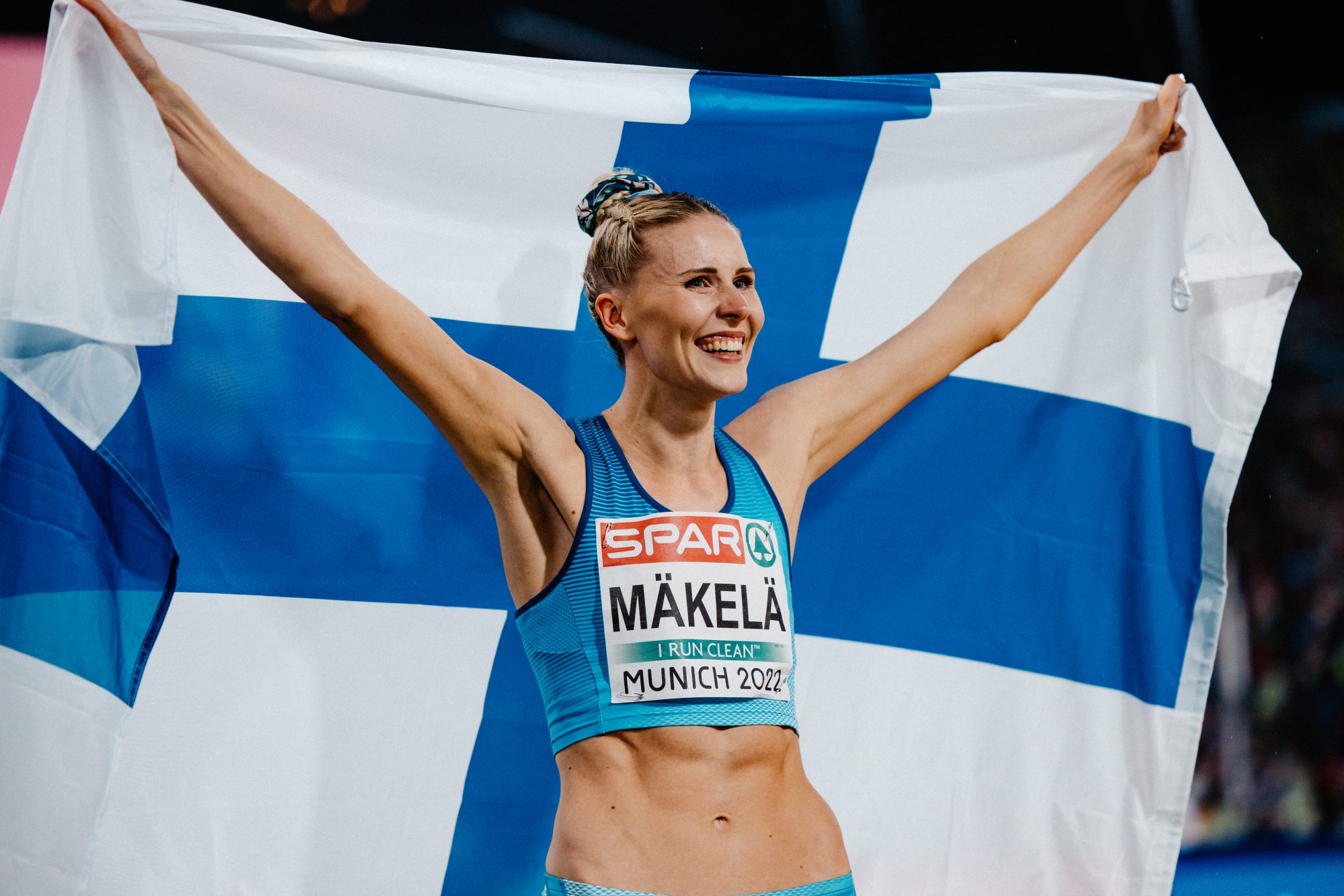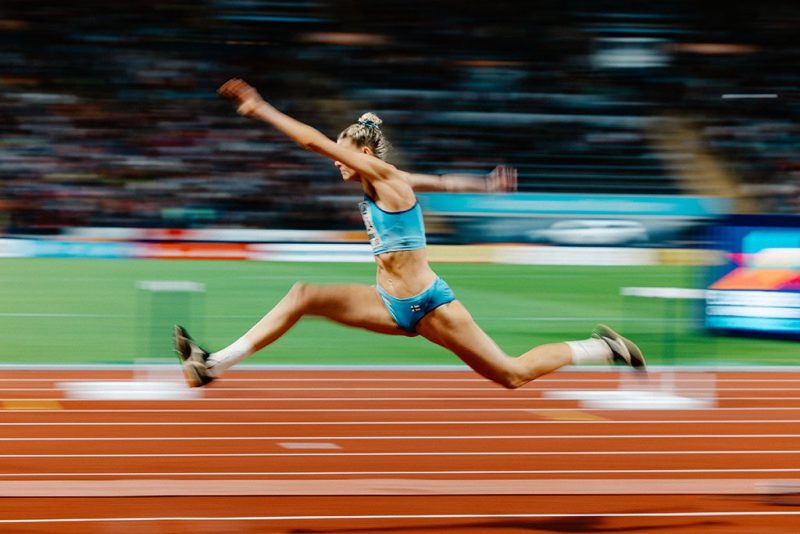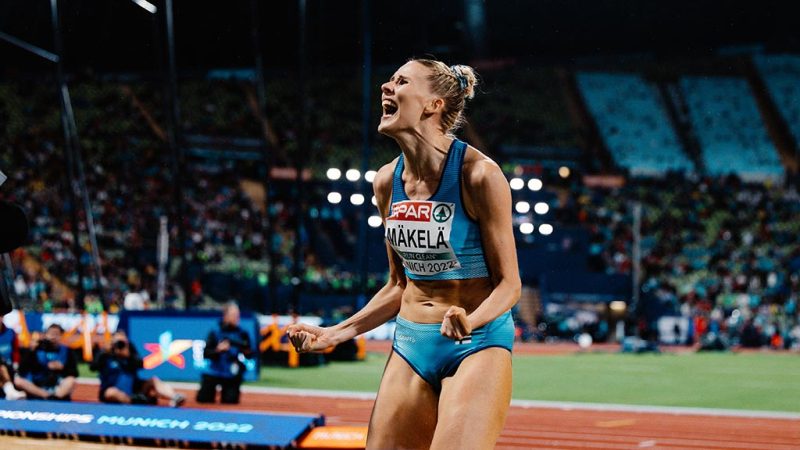Kristiina Mäkelä

European Championship Silver: 2022
The women’s Finnish record in the triple jump: 14,64 m
Finnish Championship – Triple Jump: 2009, 2011, 2015, 2016, 2017, 2018 & 2019
Finnish Championship – Triple Jump (indoor): 2012, 2015, 2016, 2017 & 2018

Kristiina Mäkelä ended up as a triple jumper somewhat accidentally after years of high jump. She’s also familiar with the parquet from her youth basketball training. Studying animal science, the jumper emphasizes that triple jump requires not only robust physics but also a healthy self-esteem – and even a certain kind of madness. According to Kristiina, triple jump is a superhuman sport.
“I was initially a high jumper. Then in the youth national championships, we were allowed to participate in other events. In 2008, you could only participate in two events. I chose triple jump and high jump. I was only the second time in high jump, and I accidentally won the triple jump! It was a surprise even to myself. I had done well in the triple jump before, and in training, I had achieved good results in jump tests.”
“In 2009, there were the U17 World Championships in Italy. In the fall, the coach and I decided to invest a little in triple jump. The summer of 2009 was perfect. I jumped over the qualification standard. I made it to the World Championships in Italy, and into the final. In the final, I jumped sixth, for the first time over 13 meters, which was then a very strong result in Finland, even for adults. After that, there were the youth Olympic Days in Finland. There, I equaled the U17 national record, finished second, and won my first medal from youth championships.”
“After that, I won the Finnish Championships, that is, the national championship, and on top of that, the Finland-Sweden match. After all this, it was quite clear that the discipline changed,” Kristiina recalls.
Jumping from the parquet to the sand
“We haven’t aimed for elite sports from a young age, but sports have been an important hobby. I come from Orimattila, and there was a very strong basketball culture. I played basketball in winter and did athletics in summer. At the age of 13, our team ended because there weren’t enough players of the same age. That’s when I switched entirely to athletics.”
“The following summer, I improved my high jump results like crazy and got my first personal coach, who brought the idea that now we’re doing this seriously, and hey, I’m good at this! That was the path that led me to individual sports, and I didn’t continue with basketball. Both of my sisters have played more basketball,” Kristiina explains.
Could Kristiina still compete with her sisters in basketball?
“In the last year when I was in youth categories, every now and then I played – and it was so much fun. At that time, I realized I was like a American player. I couldn’t handle the ball, but I had developed a lot of physical abilities in athletics.”
“A lanky-looking center was suddenly running after the opposing team’s point guard. The balls bounced nicely into my hand because I’m tall and have a long reach. Many times in a backcourt situation, I managed to block the ball from the board before it reached the basket. It was nice to return to the sport when my physical condition was so much stronger,” Kristiina reminisces about her last basketball games.

“The triple jumper must be appropriately crazy”
According to Kristiina, a triple jumper needs patience and belief in their abilities. The worst thing would be to start doubting oneself during the performance. The jumper must not give up or get upset over minor setbacks.
“You run at full speed and take as long a leap as possible on one foot, hitting the ground hard. You have to be fearless, even a little crazy. The impacts are incredibly tough. Triple jump is a sport for supermen and superwomen. After the effort, you feel sore, and you have to handle it right,” Kristiina explains.
She mentions that a long body has a lot of potential, but realizing that potential takes time.
“A long body requires a lot of muscle strengthening at first. Under the guidance of my current coach, Tuomas Sallinen, I’ve developed the most important attributes of a triple jumper: impact tolerance, endurance, and a lot of strength. Long limbs require more strength because the body mass is larger, no matter how slender you are,” Kristiina elaborates.
Raw strength alone is not enough, of course. To stay healthy, one must also refine technique. Kristiina admits with a laugh that she has only recently found the right jumping technique for her after trying various approaches for years.
Chameleon-like nature
Kristiina values versatility in life. She describes herself as a chameleon with many facets.
“I adapt to the situation, but I don’t change myself. When I need to be tough and fiery, I can be that. I also enjoy being happy and doing good things. However, in sports, it’s not enough; you need tougher aspects!”
Kristiina appreciates certain traits or ways of handling things in people. She doesn’t have one big idol. She admires a certain kind of perseverance, not just through swearing and pushing through with gritted teeth but enjoying the journey.
“It’s a great quality if, in challenging situations, one can think clearly about the world and other people,” Kristiina specifies.
According to Kristiina, the development in elite sports helps society at large. She compares an elite athlete to a racing car, where developed features eventually end up in everyday traffic.
“We tune our bodies and try to find that extreme performance. I hope that it would eventually help people take better care of their health.”
In addition to physical well-being, sports offer people great stories and emotions.
“Sports are experiences. People like big emotions. On the other hand, sports teach both the audience and the athlete to handle emotions. Disappointments grow you, and success teaches you how to handle it. Sports are not only entertainment but also an important factor that brings people together,” Kristiina reflects.
Kristiina hopes that athletic role models encourage children to play outdoors, engage in sports, and explore their abilities. She admits to dreaming of having her own family but acknowledges that the time for that will come later. “You can’t build a family during a sports career,” Kristiina notes.
In addition to sports, Kristiina is interested in nature and agriculture.
“I study domestic animal science at the University of Helsinki. It’s been a great, different perspective on marveling at this world. We all eat every day, and we have an incredibly beautiful nature in Finland and around the world – which we humans, however, know how to destroy nicely. Nature has a strong pull and an emotional connection.”

“Trust yourself. Take responsibility for your actions. Build a good team.”
Kristiina is the newest member of Team Renta. She looks forward to upcoming joint projects.
“There’s this family atmosphere at Renta. I like that the sponsor is more than just a financial supporter. Support is, of course, important and enables professionalism. At its best, collaboration is very instructive for the athlete, and great stories can emerge from it. I have followed, for example, what Renta and Topi have done together.”
In addition to support, an elite athlete needs healthy self-confidence. Kristiina shares that she has grown tremendously in that regard throughout her career.
“The trust I have gained in my career is a great thing! I have also learned that trusting oneself is the most important. You have to be able to stand honestly behind your actions and choices and trust that you are heading in the right direction. Trust yourself. Take responsibility for your actions. Build a good team around you that you can rely on. A climate of trust, where open communication is possible, is important,” reflects Kristiina.
“As a young athlete, I always asked the coach what I could achieve. Once it was told to me, I just did it. As you grow older, you understand more about the world, and you have to find yourself – that’s when self-confidence is most tested. Sometimes things go wrong. Changes in people around you are a challenging situation.”
“However, we’ve always managed by trusting ourselves. Then you can also trust others,” Kristiina summarizes.
Pictures: Jesse Väänänen | @jessevaanen